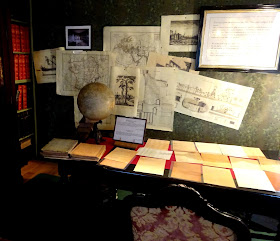One of the relatively few Maisons des Illustres, of which Jules Verne's house in rue Charles-Dubois, Amiens, is one. It is a wonderful experience, and 'experience' is the word I prefer to use rather than 'visit', as this is a little beyond the normal author's house visit – as you might expect from such a character as Verne. My purpose is to give an impression through images, as opposed to showing an image and commenting on it, although I shall certainly do so where necessary. Amiens is very much Jules Verne, but this is purely my impression of his house.
On the ground floor, a bust by J. Szarwak made in about 1900.
The dining room.
The salon, with portraits of Verne and his wife Honorine.
The first floor is largely devoted to Verne's publisher Pierre-Jules Hetzel.
Verne was a great lover of sailing, and this part of the second floor highlights this.
Verne's library and place of work.

François Schuiten added the sphère armillaire (or armillary sphere) to the tower in 2005, and the re-opening of the house was in the following year. The tromphe-l'oeil fresco is also his work:
On the ground floor, a bust by J. Szarwak made in about 1900.
The salon, with portraits of Verne and his wife Honorine.
The first floor is largely devoted to Verne's publisher Pierre-Jules Hetzel.
Verne was a great lover of sailing, and this part of the second floor highlights this.
Verne's library and place of work.

Nellie Bly (whose grave I visited in NYC) is also included in the loft here.
A representation of Jules Verne on his deathbed.
A death mask of Verne.
From the top to the bottom of the staircase. A wonderful place.
















































